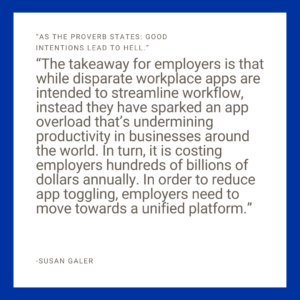How to Eliminate Digital Fatigue
The development of the computer and the software to go with them have always been designed to make tasks effortless and error-free —the true epitome of working smarter, not harder. And every year, the tech industry grows larger and larger. Innovative programs that gather and store data, solve complex equations and streamline workflows are constantly being released. These innovations ultimately help us collaborate, communicate, and create more efficiently. Software as a Service (SaaS) alone is booming; as an industry, it’s currently worth $116 billion worldwide.
There is no denying it—we are fully immersed in the digital age and even though we could all probably do our jobs without the programs we use; we definitely wouldn’t do our jobs nearly as quickly or as accurately as we do now.
For many, especially those younger generations, imagining life without a screen is like imagining life without electricity. No matter the age, there is no doubt that computer software, programs, and apps have made life easier—all business software developed is intended to help streamline workflows in some way. But when is enough enough? With companies paying for eight tools on average for employees to perform tasks in, and the ability to integrate those tools on our mobile devices, when are we ever really unplugged from work?
What is Digital Fatigue?
 Employees who have to switch between apps to do their work lose a total of 32 days a year in transition time.
Employees who have to switch between apps to do their work lose a total of 32 days a year in transition time.Have you ever gotten so overwhelmed; you were tempted to delete all of them? The struggle is real. And it has a name. Identified as tech overload, or digital or tool fatigue, this phenomenon occurs when one suffers exhaustion and frustration from the number of digital tools used in a day—especially when the programs you need to complete tasks do not integrate. Studies have shown that not only does digital fatigue cause loss of productivity, but it also negatively affects us physically, as well as lowers our IQ.
A psychiatrist at King’s College in London studied employees in 80 clinical trials and “found the IQ of those who tried to juggle messages and work fell by 10 points -- the equivalent to missing a whole night's sleep and more than double the 4-point fall seen after smoking marijuana.” (CNN.com)
The Cost to Your Company When Team Members Have Digital Fatigue
The tech overload we experience at work is a vicious cycle—multitasking so many programs that don’t talk to each other is a highly inefficient process that disrupts our flow leading to frustration and stress. The major problems of productivity loss, inefficiency, and burnout cost your company its bottom line.
- Productivity Loss
RingCentral, a communication software as a service (SaaS) company, found that employees who have to switch between apps to do their work lost a total of 32 days a year in just transition time. That’s almost an entire week lost.
Any time you have to switch between applications, it causes a distraction from the task at hand, and you lose focus. Employees spend an average of two hours total a day recovering from distractions. This means longer hours in the office and less time at home spent with loved ones and time to decompress.
Overworked and overstressed employees directly correlate to a business’s return on investment (ROI.) Liquidbase, a SaaS tool for developers writes, “Understanding what tool fatigue is, how to determine when it’s affecting an organization, and how to prevent it, can help to save time, propel projects forward, and keep ROI high. For example, imagine a database team finds a great product for doing a particular function (job A-B). The tool works well and is tactical, but then the database administration team is asked to integrate job A-B with job A-B through E. If their tool won’t integrate easily within the pipeline, or they need to add manual processes to get the job done, ROI begins to diminish. If that tool was best-of-breed and had great integration capabilities, they would be able to continue to use it and achieve the desired ROI. (Liquibase)
Are you ready for a “best in breed” integrated construction estimating tool? Reach out for your free demo of DESTINI Estimator today.
- Inefficient Process
Ironically, all these tools developed to streamline our workflows have created a massive inefficient process that causes loss of information, lack of collaborative communication, and roadblocks to completing projects.
Project management app, Wrike, found that 8 percent of baby boomers, 12 percent of Gen X’ers, and 18 percent of millennials—the generation the preconstruction industry needs to attract—have quit jobs because of inefficient operations.
- Work Burn Out
What is burnout?
Burnout occurs when an employee experiences exhaustion, disengagement, and feels negative about their job. Burnout is a very serious problem. Large Human Resources firms have even described it as an epidemic.
Research conducted by the Stanford University Graduate School of Business found that employee burnout costs the United States $190 billion in health care expenses a year. (BambooHR)
If the above problems sound all-too-familiar to you; it’s time to ask:
- How much money are we spending on all these different platforms?
- Is maintaining and fixing problems the multiple software costing us resources?
- Has the time evaluating, implementing, and training on new software taken time away from completing your job?
Each decision to introduce new software to the company comes from good intentions; however, technology is meant to help, not hinder our work process. When you are spending on average 20% of your workday just searching for information, it's time to audit and eliminate digital tool fatigue. (harmon.ie)
How to Eliminate Digital Fatigue
“Increasing efficiency through technology isn’t merely about adopting many different new technologies; it’s about adopting the right technology.” - Qualia CEO, Nate Baker
Of course, you can’t eliminate all your digital tools; there isn’t one software you can implement that will do everything. Accounting, human resources, marketing, sales…they all need specific software. But just like there are many excellent integrated software that helps those departments perform their jobs well, the preconstruction department needs software made specifically for them, too.
Moving to one unified platform that stores and recalls all your data, builds estimates, and creates reports stops the toggling between software, stops the loss of data, stops the silos of communication and information, and stops the frustration. Microsoft Outlook plug-in Harmon.ie found that “people consistently agreed that if they could have all information made available in one place, it would make their experience at work better.”
A cloud-hosted, integrated platform like Beck Technology DESTINI Estimator allows anyone access from anywhere to all the information needed to complete an accurate estimate on time. No more switching between Excel. No more copy and paste. No more time-suck finding everything you need. Just a truly efficient and cohesive process that creates estimates that wins projects. You can’t argue with that.
Build a business case for getting new construction estimating software..

-1.png?width=112&height=112&name=image%20(4)-1.png)















